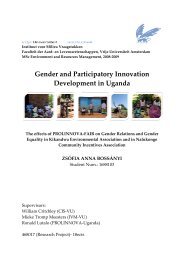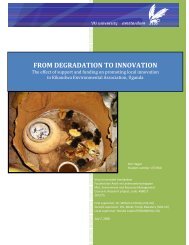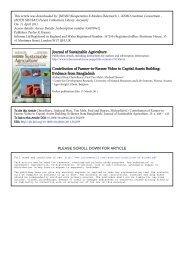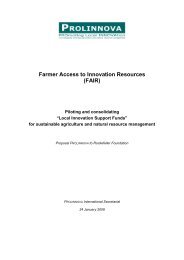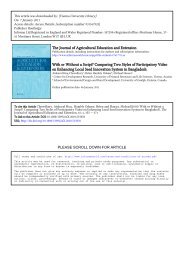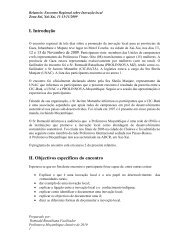Farmers' initiatives in land husbandry: promising ... - Prolinnova
Farmers' initiatives in land husbandry: promising ... - Prolinnova
Farmers' initiatives in land husbandry: promising ... - Prolinnova
Create successful ePaper yourself
Turn your PDF publications into a flip-book with our unique Google optimized e-Paper software.
Table of Contents<br />
Abbreviations and Acronyms .............................................................................. vii<br />
Foreword ......................................................................................................... viii<br />
Preface .............................................................................................................. x<br />
Acknowledgements ............................................................................................ xi<br />
Chapter 1: Introduction ....................................................................................... 1<br />
Chapter 2: Background to PFI and WOCAT ............................................................ 3<br />
2.1 Introduction .................................................................................................................... 3<br />
2.2 Promot<strong>in</strong>g Farmer Innovation (PFI) .................................................................................... 3<br />
2.2.1 The project ........................................................................................................ 3<br />
2.2.2 Farmer Innovation <strong>in</strong> context ............................................................................... 4<br />
2.2.3 Rationale for harness<strong>in</strong>g <strong>in</strong>novation ...................................................................... 4<br />
2.2.4 Limitations and threats ....................................................................................... 5<br />
2.2.5 Methodology ...................................................................................................... 5<br />
2.2.6 Experience from PFI ........................................................................................... 5<br />
2.2.7 Outstand<strong>in</strong>g Issues ............................................................................................. 6<br />
2.3 World Overview of Conservation Approaches and Technologies – WOCAT .............................. 7<br />
2.3.1 Introduction ....................................................................................................... 7<br />
2.3.2 Efficient management of exist<strong>in</strong>g knowledge ......................................................... 7<br />
2.3.3 Mak<strong>in</strong>g local experience available at the global level ............................................. 7<br />
2.3.4 Collect<strong>in</strong>g and document<strong>in</strong>g SWC knowledge ........................................................ 8<br />
2.3.5 Us<strong>in</strong>g WOCAT outputs at the field level ................................................................ 8<br />
2.3.6 Us<strong>in</strong>g WOCAT outputs at the plann<strong>in</strong>g level .......................................................... 9<br />
2.3.7 A global network with decentralised organization ................................................ 10<br />
2.3.8 More WOCAT <strong><strong>in</strong>itiatives</strong> are welcome ................................................................. 10<br />
Chapter 3: Experience <strong>in</strong> East Africa: PFI and WOCAT .......................................... 11<br />
3.1 PFI .............................................................................................................................. 11<br />
3.2 WOCAT ........................................................................................................................ 14<br />
Chapter 4: Initiatives <strong>in</strong> Land Husbandry: The Case Studies................................... 16<br />
4.1 Introduction .................................................................................................................. 16<br />
4.2 Kenya .......................................................................................................................... 17<br />
4.2.1 Road runoff harvest<strong>in</strong>g ....................................................................................... 19<br />
4.2.2 Riverbed reclamation and silt trapp<strong>in</strong>g for sugar cane ........................................... 23<br />
4.2.3 Gully rehabilitation ............................................................................................ 27<br />
4.2.4 Graz<strong>in</strong>g <strong>land</strong> improvement through selective removal of Commiphora africana trees 31<br />
4.2.5 Sugar cane plant<strong>in</strong>g pits ..................................................................................... 35<br />
4.2.6 Gully harness<strong>in</strong>g ................................................................................................ 39<br />
4.3 Tanzania ...................................................................................................................... 43<br />
4.3.1 Chololo plant<strong>in</strong>g pits .......................................................................................... 45<br />
4.3.2 Earth<strong>in</strong>g-up Groundnuts ..................................................................................... 49<br />
4.3.3 In-situ compost cultivation or ‘pattern farm<strong>in</strong>g’ (kilimo cha mfumo) ........................ 53<br />
4.3.4 Natural forest establishment ............................................................................... 57<br />
4.3.5 Mapambano compost mak<strong>in</strong>g .............................................................................. 61<br />
4.3.6 Vegetative gully heal<strong>in</strong>g ...................................................................................... 65<br />
4.4 Uganda ........................................................................................................................ 69<br />
4.4.1 Water-borne manur<strong>in</strong>g system ............................................................................ 71<br />
4.4.2 Improved trash l<strong>in</strong>es: ‘mobile compost strips’ ....................................................... 75<br />
4.4.3 Integrated runoff water management ................................................................... 79<br />
4.4.4 Mulch<strong>in</strong>g of perennial crops .............................................................................. 83<br />
v







